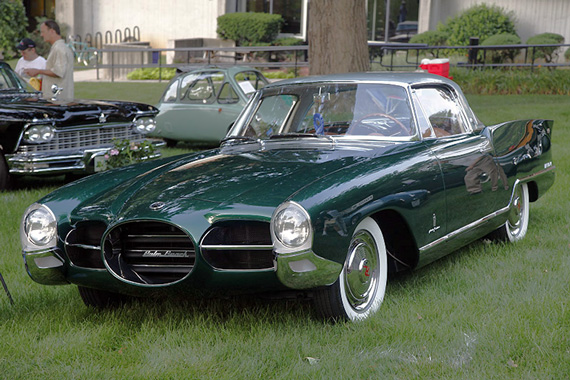
Scott Morris brought this Nash Rambler Pinin Farina Palm Beach Coupe in 2011. This was a pre-production model of a car that was intended to replace the Nash Healey as the sporting car in the Nash line. It was shown at the 1956 Paris Auto Show. Unfortunately, the company imploded before the car began production. Although this is a one off, Farina produced several cars for different makes, obviously inspired by jet fighters of the day. This car is considered one of the best in that series because the lines belie the diminutive size of the Nash.
Michael T. Lynch
The origins of the Kansas City Art Institute go back to 1885. Those who have passed through its doors as students or instructors include Walt Disney, Regionalist master Thomas Hart Benton – known as a father figure to Jackson Pollock – conceptual artist and writer Robert Morris and mixed media artist Robert Rauschenberg. Rauschenberg has an automotive connection in that he painted the sixth car (a 635 CSi) in BMW’s famed 18-piece Art Car Collection. They are just four of the thousands of individuals associated with the college. Kansas City-based global firms Hallmark, Sprint, Garmin and a vibrant art community absorb many of the graduates.

The impressive entry to the campus of the Kansas City Art Institute. The building is Vanderslice Hall. Credit KCAI
On one Sunday of the year, the Art of the Car Concours is presented on the Main Green of the KCAI campus. Lined up among historic buildings, towering oaks and outdoor sculptures, the products of the artists and engineers of the automotive world are admired. Last year, an eclectic collection of 212 vintage cars, trucks, motorcycles and pedal cars were displayed for the guests. Top prize in the show went to Peter Mullin’s Talbot-Lago T 150 CSS. The two-wheeled award went to Cooper Weeks’ 1923 Indian Chief.
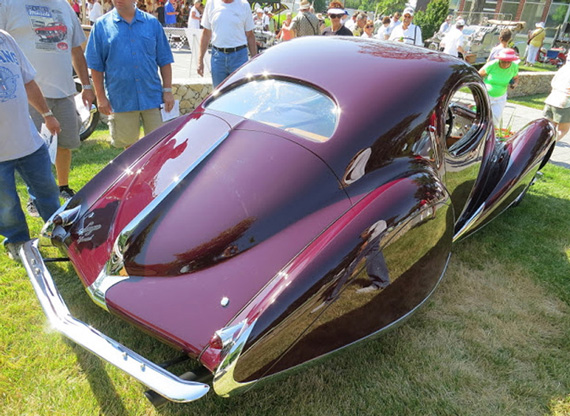
Peter Mullin’s Talbot-Lago Figoni and Falaschi T 150 CSS won People’s Choice Best of Show in 2012. The combination of Figoni’s curves and paint the color of fine French wine is absolute magic. Credit: Hovermotoco.com
Like many such events, it was created by one person and molded to fit his vision. Marshall Miller, a noted free trade zone legal pioneer, grew up in Kansas City. His father liked cars, but family finances didn’t allow for any exotics. However, Miller’s father Leon did encourage his son’s interest with a Road & Track subscription from the early 1950s. Miller first got involved with collector cars when he bought a 1931 Ford Model A for his father in 2000. It was the same year, model and color of his father’s first car. Miller’s own first collectable was an MG TC, like those he had admired in Road & Track so long ago. Miller, his father and his two sons began to go to concours around the country including Pebble Beach and Amelia Island. Soon, Miller wanted his Kansas City neighbors to experience the great cars he had been privileged to see in his travels. Since no similar event occurred in Chicago, Denver, St. Louis or Dallas, Miller created a venue in the Midwest for vintage vehicle owners and those interested in viewing them.
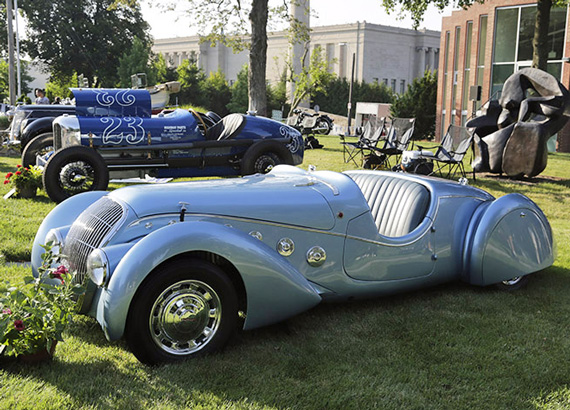
Mark Hyman’s Peugeot 402 Darl’mat was commissioned by Emile Darl’mat, a Paris Peugeot dealer. The body was drawn by George Paulin and executed by Marcel Portout. This one won a special Paulin/Portout class at Pebble Beach. The car in the background is a recreation of Ralph Hepburn’s 1933 Cooper-Marmon V-16 Indy car. It was commissioned by John Hollansworth and built by Bob Schumacher of Vintage Fabrication in suburban Kansas City. The sculpture is ‘Untitled’ by the late Lester Goldman, a painting instructor at KCAI for 40 years. It is on loan to KCAI from Trustee Brad Nicholson. Credit Tom Strongman
He approached the Kansas City Art Institute about using their grounds. Since Miller’s wife Janet had been on the Board for twenty years, the last five as Chairman, it wasn’t a difficult negotiation. Miller wanted to keep things simple, low cost and eclectic, so he eliminated judging and classes, resulting in a collegial rather than competitive atmosphere. There are still thirty odd awards, but sponsors and the public decide who wins them and who gets the trophies. The latter are mostly designed by Art Institute students and alumni.
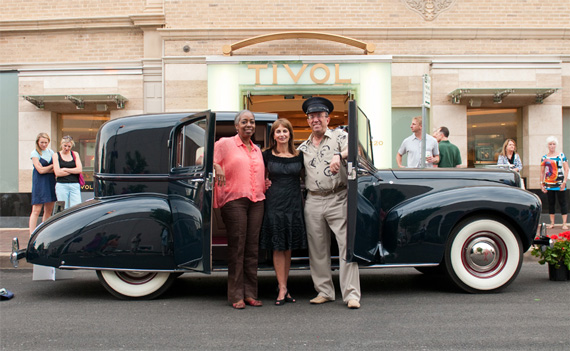
From the left, Jacqueline Chanda, President of the Kansas City Art Institute, Cathy Tivol, CEO of Tivol and Marshall Miller, Organizer of the Art of the Car Concours. The site is in front of Tivol Jewlers, which hosts a Saturday morning entrant's reception at their store on the Country Club Plaza. A dozen or so cars are displayed on the street to allow the public a preview of the next day’s concours. The car is Miller’s Lincoln-Zephyr Brunn Town Car Limousine. Designed by Edsel Ford, ten were made, this is the second. It is documented that No.1 went to Mrs. Henry Ford and No.3 went to Edsel. The supposition is that this one belonged to Henry himself. Credit Mark McDonald
The sponsors are encouraged to add a dash of humor to the proceedings. Hagerty Insurance’s award is, “The Car We Would Most Like to Get a Claim From.” Tivol, the city’s leading jeweler, whose award is the “Jewel of a Car”, provides a Saturday exhibitor brunch at their location on the nearby Country Club Plaza. A preview of select cars is held in front of their building the same day to promote the next day’s concours. The Plaza, built by J. C. Nichols, a visionary developer, is considered to be the country’s first auto-centric shopping center.
The fact that Miller is the head of a large enterprise is evident in both the concours’ organization and in some of his decisions. The Kansas City Art Institute provides public relations, advertising, website services, grounds management, security, event check-in and financial management. Miller has recruited 28 managers with specific areas of responsibility and 150 volunteers, most long-standing.
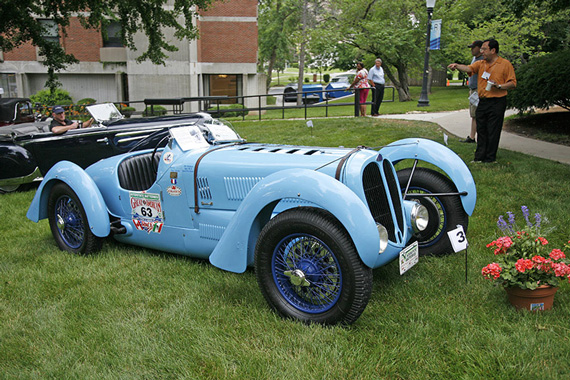
John Baeke’s Delahaye 135 awaits the crowds while Mark Hyman’s Delahaye 135M Figoni and Falaschi Cabriolet pulls into place. Baeke’s car replicates the days of French sports car dominance immediately before World War II when a similar car won Le Mans in 1938. Credit Tom Strongman
When Miller heard from one concours organizer that the impresario had come up $195,000 short after not meeting an attendance guarantee at a gala pre-concours dinner, a much more modest reception was included in the Art of the Car schedule with a $20 admission fee. Vehicle applicants are charged $100. Additional contributions to the KCAI scholarship fund are strongly encouraged and $100 to $1000 are routinely contributed by exhibitors. One principle has been continuous; Miller and other underwriters cover all the expenses so the KCAI scholarship fund receives all revenue plus exposure to thousands of people on their campus where they learn more about the school and its educational services.
The seventh edition of Art of the Car will take place on Sunday, June 23rd. Those used to the nosebleed prices extracted during Monterey’s automotive Holy Week will be happy to learn that $12 in advance and $15 at the door will allow you admission to a show that has continually upped the quality of the cars displayed.
This year will feature a special Saturday event, “Meet the Legends – A Conversation with Sir Stirling Moss, Denise McCluggage – Remembering Masten Gregory.” Gregory, a Kansas City native, was one of the earliest Americans to make an impression in European road racing after World War II, and a well-known character in an era known for idiosyncratic race drivers. Since Moss and McCluggage are raconteurs of the first order, the afternoon promises to be a memorable one. Masten’s brother, Riddelle, a racer in period, and a story teller in his own right, will also be present.
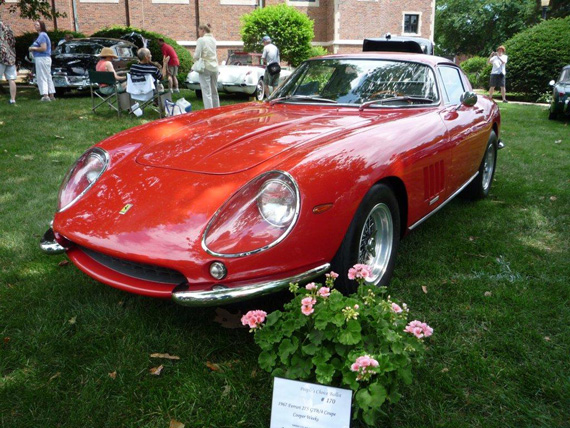
Long time fine art and Ferrari connoisser Cooper Weeks brought this 275 GTB/4 in 2009. Curves Ahead, an auto transportation company, gave it an award as ‘The Car We Would Most Like to Pick Up and Keep’. Credit KCAI.
My advice is to come a day early for the Saturday/Sunday events. The Plaza has many hotel options and hundreds of shops and restaurants. Right across the street from the Art Institute is the Nelson Atkins Museum of Art, one of the country’s finest. One of the exhibitions that will be mounted at the time of the concours is Modern Mexican Masterpieces with an emphasis on the work of Frida Kahlo and Diego Rivera.
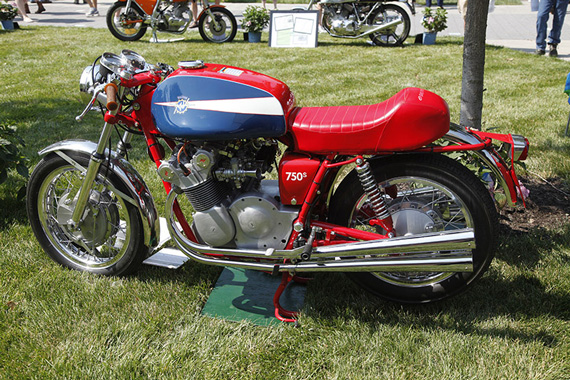
Dale Keesecker’s MV Agusta 750S dates from the glory days when the firm was building its legacy of 27 Rider’s and Manufacturer’s Motorcycle Grand Prix World Championships. In 2011, it won the Most Beautiful Italian Vehicle Award. Credit Tom Strongman
For more information on the Art of the Car, visit www.artofthecarconcours.com

Very interesting story in that I think the art & history angles are two more reasons to go to car events, not just the cars themselves. Maybe there’s still time to get that biographer of Masten Gregory onto the program–Masten’s never given enough credit. As a bespectacled guy myself, he was one of my racing heroes.
Also on the Palm Beach, I remember seeing that in some small car magazine at least 50 years ago and wondering where it went. Is it true it was found in the estate of Roy Chapin, the former head of the firm, in relatively good condition? I didn’t know Mr. Hyman was displaying classics–I know he’s a famous collector car dealer. Maybe Mr. Lynch can interview him–Hyman seems to have a classic taste.
wonderful story by Michael Lynch,,a man who will go to any length for research and gather details.whewnb it comes to automotivew historyu, he is like a dog
with a bone!Masten did go oveer to Europe first(1954) both Phil Hill and Shelby
laughed at him in Santa Monica whenb he toild them his plans.(Gregory was waiting for repairs on his Ferrari 375 after Pebble Beach crash.
Jim Sitz
Oregon
The shot of the Mullin Talbot Teardrop coupe in purple is the best I’ve ever seen! Dave Cummins